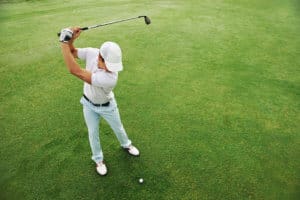Sure, the game of golf is fun to play, but did you know that you’re learning about physics while you’re out on the green? There are a few key physics concepts that make an enormous difference in your performance. It may seem like such a simple action to swing a club and hit a ball towards your target. Yet, once you perfect how to optimize these three physics concepts for golf, you’ll have an edge on your competition at the next tournament.
 The Double Pendulum Effect
The Double Pendulum Effect
A pendulum is simply a weight suspended from an anchor where the weight can pivot or swing freely under the influence of gravity. Pendulums are essential mechanical elements to keep accurate time in traditional clocks and help musicians keep an even beat when playing an instrument. When a golfer swings the club at the ball, two pendulums are in motion.
The first pendulum is formed in the upper body. The wrist acts as the ball of the pendulum attached by the arms and anchored to the shoulders.
The second pendulum is the golf club head attached by the club shaft and hands and is anchored to the wrist.
These pendulums swing independently, but when the proper technique is used for each, their interactions create a strong golf swing.
Centripetal force
Centripetal force is a force that makes an object move in a curved motion. For example, the gravitational force of the sun keeps the Earth and other planets circling around it versus flying off into deep space. If you’ve ever been roller skating and spun a buddy around you in quick circles, you’ve created centripetal force. Centripetal force involves a forward motion combined with a backward pull, resulting in a strong, circular motion.
A golfer creates centripetal force with their swing. The golf club swings outward in a circular motion around the golfer by anchoring the lower part of the body and forcefully down towards the ball while pulling backward at the wrists.
Another critical aspect of centripetal force is that the more distance between the anchor point and the endpoint, the faster the endpoint will travel. That means that a longer club has the potential to strike the ball faster than a shorter one. Likewise, that also means that a longer club requires less centripetal force to travel at the same speed as a shorter club.
Torque
Torque is the turning force that changes the rate of rotation in an object. Scientists call this “force times distance.” To understand torque, consider using a wrench as a lever to tighten a bolt. A longer wrench will give you more leverage and make it easier to turn the bolt than a short wrench. The same holds true for the swing of a golf club.
To create more torque, rotate as much as possible through your shoulders and hips. By doing so, you’re extending the length of the “club” all the way through your shoulders and body.
For more training tips like understanding physics concepts for golf, contact our Eagle Point Golf Club Academy.
We encourage our members and guests at the Eagle Point Golf Club to take advantage of personalized tune-up sessions. These mini-lessons are designed to help golfers warm up and fine-tune a handful of skills before hitting the greens. During a session, we’ll introduce you to some easy warm-up exercises designed to achieve balance and alignment on the course.
Next, one of our professional trainers will observe your swing in a few different scenarios. We’ll pinpoint specific issues getting in the way of your game, such as aligning the perfect swing on the chipping green. Next, we’ll introduce a few simple exercises for you to practice to perfect your short game. By targeting just a few critical items, you’ll be headed to your game in no time with a manageable number of techniques to practice.
If you’re ready to take your game to the next level, call the Eagle Point Golf Club at 541-826-8225 to inquire about golf lessons. We’re excited to see your game improve!

Leave a Reply